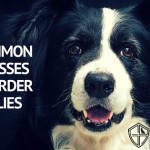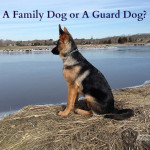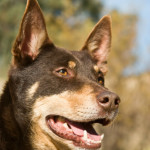The Eyes Have It: Normal Canine Vision
The Eyes Have It
Vision is extremely important for herding dogs, whether it is used in their daily life or for dog sports. But for working dogs, it is especially important. When your herding dog is sent on an outrun after livestock, his eyes will be looking for stock as he runs. In an arena trial, the stock will easily be seen, but this isn’t the case in a big open field Border Collie trial.
There are some myths about canine vision that research has put to rest. One is that dogs can only see black, white and shades of gray. While dogs are somewhat “colorblind”, they do see blues and yellows as well as the grays. Basically, dogs have two types of “cone” cells in their retina. Humans have three, which gives us the broader set of colors.

Spectrum for Dogs

Spectrum for Humans
In addition, dogs can distinguish items by their brightness. It was once felt that dogs only discriminated by brightness and not at all by color. A research study performed in Russia and reported in the Smithsonian showed that dogs actually do use color to tell items apart – assuming it is a color within their range.
Color vision really doesn’t matter much for herding dogs except in agility when certain color jumps may be more difficult to spot. For herding, livestock often contrast with the environment, such as white sheep on green or brown fields.
The field of view for a dog may vary with breed. Predators in general have a narrow field of vision. Dogs have about 240 degrees of view versus a prey animal, like a horse, who has a 357 degree view. Sighthounds use a wide field to look for any prey or movement. Herding dogs are similar – they are searching for their livestock. After all, herding behaviors are modified prey behaviors.
Depth perception is used by a dog to determine where objects are and to adjust to their environment accordingly. While the retina looks at the world in two dimensions, our world is really three dimensions. Dogs use their binocular vision – when the field of vision for their eyes overlaps – to help them with depth perception. A dog who goes blind in one eye may have some problems with this until he adjusts to only having input from one eye.
Dogs have about 30 to 60 degrees of visual overlap versus 180 degrees for people. Still, most dogs can easily catch a tossed ball or a flying disc with ease. The degree of overlap is somewhat influenced by head and muzzle shape. Most herding breeds have “normal” muzzles - not shortened ones like Pugs and other brachycephalic dogs.
Dogs do excel in picking up motion. They have lots of rod cells in their retinas which help them to see in dim light and in detecting motion. If you think about it, a herding dog needs to detect any movement that could be livestock. A study done in the early 1900s with police dogs showed that the dogs could detect moving objects as far away as 900 yards. If the objects were stationary, the dogs only picked them out at about 585 yards.
A question many families ask is, “Can our dog watch TV?” The answer is maybe/sort of. Most older TVs have a “flicker rate” that probably leaves dogs with a headache as the image appears to be flickering to them. Newer, high definition TVs more closely match a dog’s ability. There are also differences in breeds – dogs with rounder eyes are generally more interested in TV. Of my current three dogs, the Australian Shepherd is the TV watcher, while the Belgian Tervurens generally ignore it. The newer release of Narnia is actually Baloo’s favorite movie to watch, though he enjoys any show with lots of action! Still, don’t count on leaving training videos for your dog to watch and assume he will learn from them.
It is generally accepted that many, if not most, dogs are nearsighted or myopic. Dogs can be selected for their visual acuity. A study of pet German Shepherd Dogs showed about 53% of them to be myopic while only 15% of the German Shepherd Dogs used in a guide dog program were nearsighted.
There is a fun site available that shows you how things would appear to a dog. This widget lets you see the world through a dog’s eyes.
Dogs do rely on their hearing and sense of smell more than vision to relate to their surroundings. Still, vision is important for many life activities, dog sports and of course, livestock herding.
You can learn about a herding breed dog’s acquired eye problems here.
To know more about a herding breed dog’s inherited eye problems, click here.
RESOURCES:
Smithsonian: New Study Shows That Dogs Use Color Vision After All
JAVMA Vol 207 No. 12, December 15, 1995. Leading Edge of Medicine - A Review
Article By:
Deb M. Eldredge, DVM
Meet Our Evangelist







